When German companies launch a new luxury sedan, they chat about more power, better economy, and leveraged links to Silicon Valley's hottest microchip and graphics powerhouses. It's not like that in Italy. The Mediterranean peninsula only has one authentic maker of luxury sedans, and cutting-edge consumer technology has never been Maserati's forte.
Beautiful cars, sure. Compelling engine notes, yup. The prioritization of handling emotion above cornering speed and even ride quality? Absolutely. Three years ago Maserati thought that blueprint would be enough for its all-new Quattroporte. It wasn't.
For starters, the car wasn't beautiful. Compared to the filigreed purity of its predecessor, the QP (as they call it in Modena) looked awkward, even clunky. A big part of that was the sheer scope of the 124.8-inch wheelbase, which made it nigh impossible to deliver the proportional elegance and unfussed panel pressings of its predecessor. Still, the added length provided rear legroom that takes surveyors to measure.
More important than what it had (and whether that was good or bad) was what it didn't have. There was no button on the remote to open the trunk, no self-parking system, no reversing camera, definitely no 360-degree camera setup, no radar cruise control, no semi-autonomous steering, and no modern navigation or infotainment.
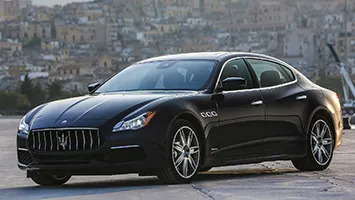

By far the biggest Maserati (at 207.2 inches, it dwarfs most of the standard versions of almost any sedan, anywhere), the Quattroporte now has some small visual changes and enough driver-assistance stuff (like radar cruise) to bring it up to German levels. At least, that's the on-paper argument.
Not one of the 2017 model's visual upgrades is metallic. The changes include a new plastic grille (inspired by the design language of the Alfieri concept car), updated lights, and some very subtle differences between the sportier GranSport and the more luxurious GranLusso versions, two new trim packages.
The aero guys have been busy, too, with a flat floor and a new Air Shutter that lowers drag by 10 percent and by itself improves the fuel consumption by three percent (anything else is down to stop-start).
In a tech, tech, tech world, the Quattroporte is the anti-Tesla. There are no plans to give the big boy any form of hybrid power much less a plug-in hybrid powertrain. Maserati's engineers look at you funny for mentioning hydrogen fuel cell or battery-electric power. Instead, Maserati loves a good internal-combustion motor, which is odd because it doesn't make any right now. The diesel V6 not sold in the US comes from nearby VM Motori, while Ferrari knocks out the fun stuff (in, admittedly, a plant it built with Maserati's money).
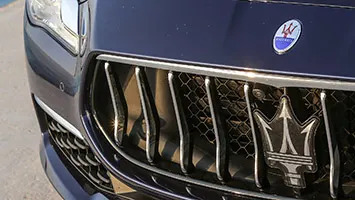

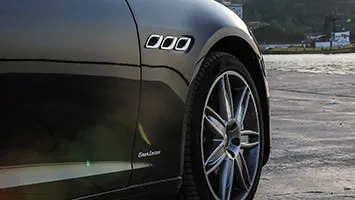
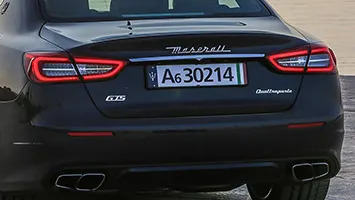
The car again comes with a choice of two gas engines, neither of which has been touched as part of this update. The S and all-wheel-drive S Q4 Models use a 3.0-liter twin-turbocharged V6 that makes 404 horsepower and 406 pound-feet of torque. Interestingly, an updated, 424-hp version of this engine that launched in the Levante crossover doesn't make it to the big sedan. The QP's other engine is the GTS model's twin-turbo 3.8-liter V8, which puts out 523 hp and 524 lb-ft. The V8 is only paired with rear-wheel drive because adding a front driveshaft would be a packaging nightmare that's not worth the small number of added sales. Both engines are hooked to ZF's ubiquitous eight-speed automatic transmission, which works cleanly and efficiently.
The absence of a front diff explains why the V8 only claims a two-tenths advantage over the S Q4 to 60 mph, hitting the mark in 4.6 seconds. Given that the rear-drive S does the run in 4.9 seconds, you have to figure a hypothetical all-wheel-drive V8 could knock that down to 4.4.
If the engines haven't been even lightly fiddled in the facelift, there are good reasons. They're both pretty nice sports engines that do an excellent job of masquerading as undercover luxury motors.
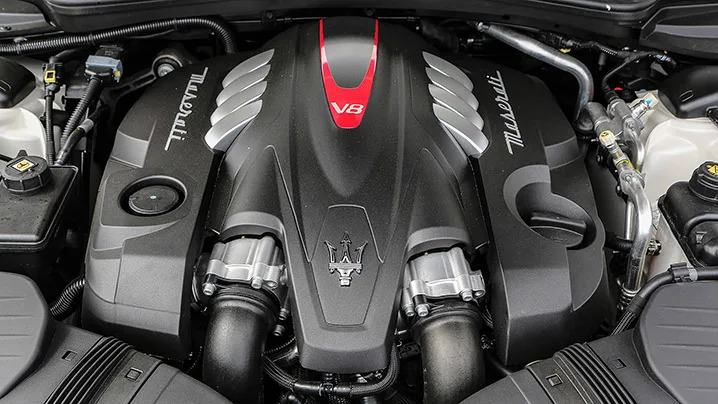
The chassis, with its five-link rear end and Skyhook active damping, hasn't had much tweaking either, though it could have used some love. It lifts wheels here and there and its pieces sometimes feel like they're not all working in harmony.
A wheelbase this long will always help the ride and the progressiveness of the handling, and those things are still Quattroporte hallmarks. It forgives mistakes, there's little pitch or squat under braking or acceleration (a feat accomplished via old-school suspension engineering rather than electronic means) and the big machine is very easy to drive quickly.
The GTS GranLusso has a wonderfully old-fashioned character, with a big engine note and big performance that doesn't ever dominate a machine noted as much for its exquisite leather stitching as for its hardware. The car's stability in hard cornering is astonishing. It can be unsettled, but it tells you of any upcoming loss of grip and what you should do about it well before it becomes a problem that could spit you off the road. It's disturbingly easy to slide the massive machine, too, at either end, and it's so comprehensively competent that turning off the skid-control systems seems to make very little difference to the way it behaves.
The GranLusso and GranSport both ride well, with calm composure for the most part and only occasional springy hits from the back end over things like expansion joints, and they both have a reassuring way of making it feel like you're easing your way around difficult roads, even when you're pushing quite hard. The caveat is that over high-frequency bumps at speed, a shimmy through the cabin can develop as the Skyhook active suspension system struggles to keep up with the incessant demands from the sensors on the dampers. And, for the last car in this class with an old-school hydraulic steering system, it doesn't have the delicacy of steering feedback that seems to be at its disposal.
The strength of the V8 engine is obvious from the moment you find the mysteriously hidden start button, waking it up with threatening depth and constrained anger. Then you push the Sport button and the exhaust valves open up to give the engine its full voice. Its turbochargers don't follow the trend to nestle within the hot vee, but they still manage to be properly responsive at every point in the rev range. Unlike most of the big German motors, this V8 is significantly oversquare, which makes it feel like it wants to rev and rev and it always feels like a bit of a surprise when the limiter kicks in and the auto changes to the next cog.

The V8 is easily capable of spinning up the rear wheels in a straight line at 55 mph, so it can obliterate the rubber from a standing start. It's also so strong in its mid-range that overtaking doesn't demand a gap much bigger than the car itself, which is still a pretty big gap.
The V6 is, surprisingly, almost as convincing. It is the least V6-sounding V6 out there, with depth and rumbling smoothness and fun, even if the throttle response isn't as rapid as it is with the V8.
The Quattroporte is a little slower in Q4 form than with the V8, in both the real world and in theory. It loses a little on in-gear acceleration, but makes up for it on being stubbornly grippy from a standing start and out of corners.
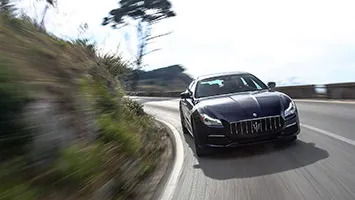
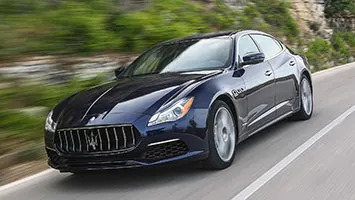
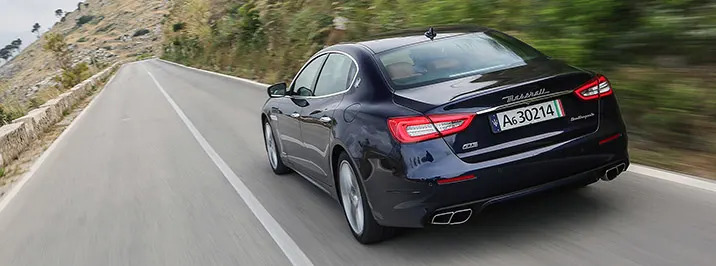
That brings us to the good and bad of the Quattroporte's upgrades. Good, because they were desperately needed to climb up to the segment's baseline. Bad because it only gets to the baseline on paper with some technologies and in no area does it blow past it.
The active cruise control, for example, feels a generation behind the intuitive system Audi just debuted in its Q7 and A4 and the one BMW uses in its newest 7 Series. Those systems show off their software coding by re-accelerating the instant something moves out of the way; the Quattroporte needs to wait until the car/truck/bus has long gone before punching the throttle again. It can be a bit infuriating. Still, the system brakes the car to a stop and, if things get moving again within a few seconds, accelerates away again without driver intervention.
Then there are the optional 360-degree and reversing cameras. Yes, they're there and they're helpful when you're parking a car this size, but the images projected on the new 8.4-inch multimedia screen are forgot-my-glasses fuzzy compared to what the Germans offer. That makes park-by-screen less accurate than it needs to be. Self-parking and any other steering-based assist systems are still absent because they require an electric power steering system the Quattroporte doesn't have.

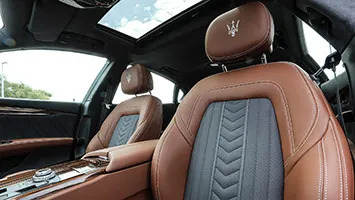
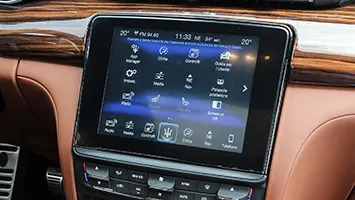
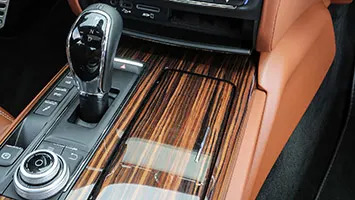
It mates the multimedia screen with mirroring systems for Apple's CarPlay and Android Auto but it has slots for just a single USB connector and an SD card (remember them?). It uses the same double-decker scrolling system as the Levante and it manages the whole shooting match, from the seat heating and cooling to the audio to the navigation to the rolling wifi hotspot.
It's delivered the option of 10.2-inch LCD screens in the rear so the kids can watch either shared or unique content and they've thoughtfully delivered a remote control unit to drive it all, on the assumption that anybody who hasn't played in the NBA won't be able to reach the back of the front seats.
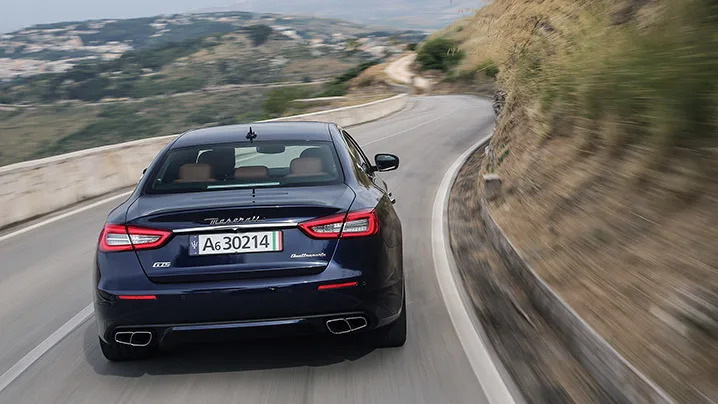
The navigation seems to be the weak link, with our car's screen freezing four times, once for 10 minutes, and then returning only to tell us we were driving in the Tyrrhenian Sea. That's partly offset by the Quattroporte running a level of style and class in the interior that even the clearly higher consumer technology of the Germans can't match. Maserati's hand-stitched leather interiors are exquisite, and the aluminum shift paddles are compellingly touchable, while the GranLusso runs (optional) silk trim for the seat and doors.
There are jarring notes, though, with the chrome plastic trim pieces across the air vents and instrument cluster looking and feeling far from premium, the cup holder's cover closing with an undamped clunk, and the roof lining flexing flimsily when you use the buttons Maserati has left up there.
At its core, the Quattoporte is a solidly good car, but it always was. It just lacked the kind of technology that buyers of big German sedans took for granted. Now that it has that tech (most of it, at least), it's a much more credible contender. It's just a shame it's not better in some areas that seem pretty visible, because the core of the car deserves it.
Related Video:

Beautiful cars, sure. Compelling engine notes, yup. The prioritization of handling emotion above cornering speed and even ride quality? Absolutely. Three years ago Maserati thought that blueprint would be enough for its all-new Quattroporte. It wasn't.
For starters, the car wasn't beautiful. Compared to the filigreed purity of its predecessor, the QP (as they call it in Modena) looked awkward, even clunky. A big part of that was the sheer scope of the 124.8-inch wheelbase, which made it nigh impossible to deliver the proportional elegance and unfussed panel pressings of its predecessor. Still, the added length provided rear legroom that takes surveyors to measure.
More important than what it had (and whether that was good or bad) was what it didn't have. There was no button on the remote to open the trunk, no self-parking system, no reversing camera, definitely no 360-degree camera setup, no radar cruise control, no semi-autonomous steering, and no modern navigation or infotainment.


By far the biggest Maserati (at 207.2 inches, it dwarfs most of the standard versions of almost any sedan, anywhere), the Quattroporte now has some small visual changes and enough driver-assistance stuff (like radar cruise) to bring it up to German levels. At least, that's the on-paper argument.
Not one of the 2017 model's visual upgrades is metallic. The changes include a new plastic grille (inspired by the design language of the Alfieri concept car), updated lights, and some very subtle differences between the sportier GranSport and the more luxurious GranLusso versions, two new trim packages.
The aero guys have been busy, too, with a flat floor and a new Air Shutter that lowers drag by 10 percent and by itself improves the fuel consumption by three percent (anything else is down to stop-start).
In a tech, tech, tech world, the Quattroporte is the anti-Tesla. There are no plans to give the big boy any form of hybrid power much less a plug-in hybrid powertrain. Maserati's engineers look at you funny for mentioning hydrogen fuel cell or battery-electric power. Instead, Maserati loves a good internal-combustion motor, which is odd because it doesn't make any right now. The diesel V6 not sold in the US comes from nearby VM Motori, while Ferrari knocks out the fun stuff (in, admittedly, a plant it built with Maserati's money).




The car again comes with a choice of two gas engines, neither of which has been touched as part of this update. The S and all-wheel-drive S Q4 Models use a 3.0-liter twin-turbocharged V6 that makes 404 horsepower and 406 pound-feet of torque. Interestingly, an updated, 424-hp version of this engine that launched in the Levante crossover doesn't make it to the big sedan. The QP's other engine is the GTS model's twin-turbo 3.8-liter V8, which puts out 523 hp and 524 lb-ft. The V8 is only paired with rear-wheel drive because adding a front driveshaft would be a packaging nightmare that's not worth the small number of added sales. Both engines are hooked to ZF's ubiquitous eight-speed automatic transmission, which works cleanly and efficiently.
The absence of a front diff explains why the V8 only claims a two-tenths advantage over the S Q4 to 60 mph, hitting the mark in 4.6 seconds. Given that the rear-drive S does the run in 4.9 seconds, you have to figure a hypothetical all-wheel-drive V8 could knock that down to 4.4.
If the engines haven't been even lightly fiddled in the facelift, there are good reasons. They're both pretty nice sports engines that do an excellent job of masquerading as undercover luxury motors.

The chassis, with its five-link rear end and Skyhook active damping, hasn't had much tweaking either, though it could have used some love. It lifts wheels here and there and its pieces sometimes feel like they're not all working in harmony.
A wheelbase this long will always help the ride and the progressiveness of the handling, and those things are still Quattroporte hallmarks. It forgives mistakes, there's little pitch or squat under braking or acceleration (a feat accomplished via old-school suspension engineering rather than electronic means) and the big machine is very easy to drive quickly.
The GTS GranLusso has a wonderfully old-fashioned character, with a big engine note and big performance that doesn't ever dominate a machine noted as much for its exquisite leather stitching as for its hardware. The car's stability in hard cornering is astonishing. It can be unsettled, but it tells you of any upcoming loss of grip and what you should do about it well before it becomes a problem that could spit you off the road. It's disturbingly easy to slide the massive machine, too, at either end, and it's so comprehensively competent that turning off the skid-control systems seems to make very little difference to the way it behaves.
The GranLusso and GranSport both ride well, with calm composure for the most part and only occasional springy hits from the back end over things like expansion joints, and they both have a reassuring way of making it feel like you're easing your way around difficult roads, even when you're pushing quite hard. The caveat is that over high-frequency bumps at speed, a shimmy through the cabin can develop as the Skyhook active suspension system struggles to keep up with the incessant demands from the sensors on the dampers. And, for the last car in this class with an old-school hydraulic steering system, it doesn't have the delicacy of steering feedback that seems to be at its disposal.
The strength of the V8 engine is obvious from the moment you find the mysteriously hidden start button, waking it up with threatening depth and constrained anger. Then you push the Sport button and the exhaust valves open up to give the engine its full voice. Its turbochargers don't follow the trend to nestle within the hot vee, but they still manage to be properly responsive at every point in the rev range. Unlike most of the big German motors, this V8 is significantly oversquare, which makes it feel like it wants to rev and rev and it always feels like a bit of a surprise when the limiter kicks in and the auto changes to the next cog.

The V8 is easily capable of spinning up the rear wheels in a straight line at 55 mph, so it can obliterate the rubber from a standing start. It's also so strong in its mid-range that overtaking doesn't demand a gap much bigger than the car itself, which is still a pretty big gap.
The V6 is, surprisingly, almost as convincing. It is the least V6-sounding V6 out there, with depth and rumbling smoothness and fun, even if the throttle response isn't as rapid as it is with the V8.
The Quattroporte is a little slower in Q4 form than with the V8, in both the real world and in theory. It loses a little on in-gear acceleration, but makes up for it on being stubbornly grippy from a standing start and out of corners.



That brings us to the good and bad of the Quattroporte's upgrades. Good, because they were desperately needed to climb up to the segment's baseline. Bad because it only gets to the baseline on paper with some technologies and in no area does it blow past it.
The active cruise control, for example, feels a generation behind the intuitive system Audi just debuted in its Q7 and A4 and the one BMW uses in its newest 7 Series. Those systems show off their software coding by re-accelerating the instant something moves out of the way; the Quattroporte needs to wait until the car/truck/bus has long gone before punching the throttle again. It can be a bit infuriating. Still, the system brakes the car to a stop and, if things get moving again within a few seconds, accelerates away again without driver intervention.
Then there are the optional 360-degree and reversing cameras. Yes, they're there and they're helpful when you're parking a car this size, but the images projected on the new 8.4-inch multimedia screen are forgot-my-glasses fuzzy compared to what the Germans offer. That makes park-by-screen less accurate than it needs to be. Self-parking and any other steering-based assist systems are still absent because they require an electric power steering system the Quattroporte doesn't have.




It mates the multimedia screen with mirroring systems for Apple's CarPlay and Android Auto but it has slots for just a single USB connector and an SD card (remember them?). It uses the same double-decker scrolling system as the Levante and it manages the whole shooting match, from the seat heating and cooling to the audio to the navigation to the rolling wifi hotspot.
It's delivered the option of 10.2-inch LCD screens in the rear so the kids can watch either shared or unique content and they've thoughtfully delivered a remote control unit to drive it all, on the assumption that anybody who hasn't played in the NBA won't be able to reach the back of the front seats.

The navigation seems to be the weak link, with our car's screen freezing four times, once for 10 minutes, and then returning only to tell us we were driving in the Tyrrhenian Sea. That's partly offset by the Quattroporte running a level of style and class in the interior that even the clearly higher consumer technology of the Germans can't match. Maserati's hand-stitched leather interiors are exquisite, and the aluminum shift paddles are compellingly touchable, while the GranLusso runs (optional) silk trim for the seat and doors.
There are jarring notes, though, with the chrome plastic trim pieces across the air vents and instrument cluster looking and feeling far from premium, the cup holder's cover closing with an undamped clunk, and the roof lining flexing flimsily when you use the buttons Maserati has left up there.
At its core, the Quattoporte is a solidly good car, but it always was. It just lacked the kind of technology that buyers of big German sedans took for granted. Now that it has that tech (most of it, at least), it's a much more credible contender. It's just a shame it's not better in some areas that seem pretty visible, because the core of the car deserves it.
Related Video:

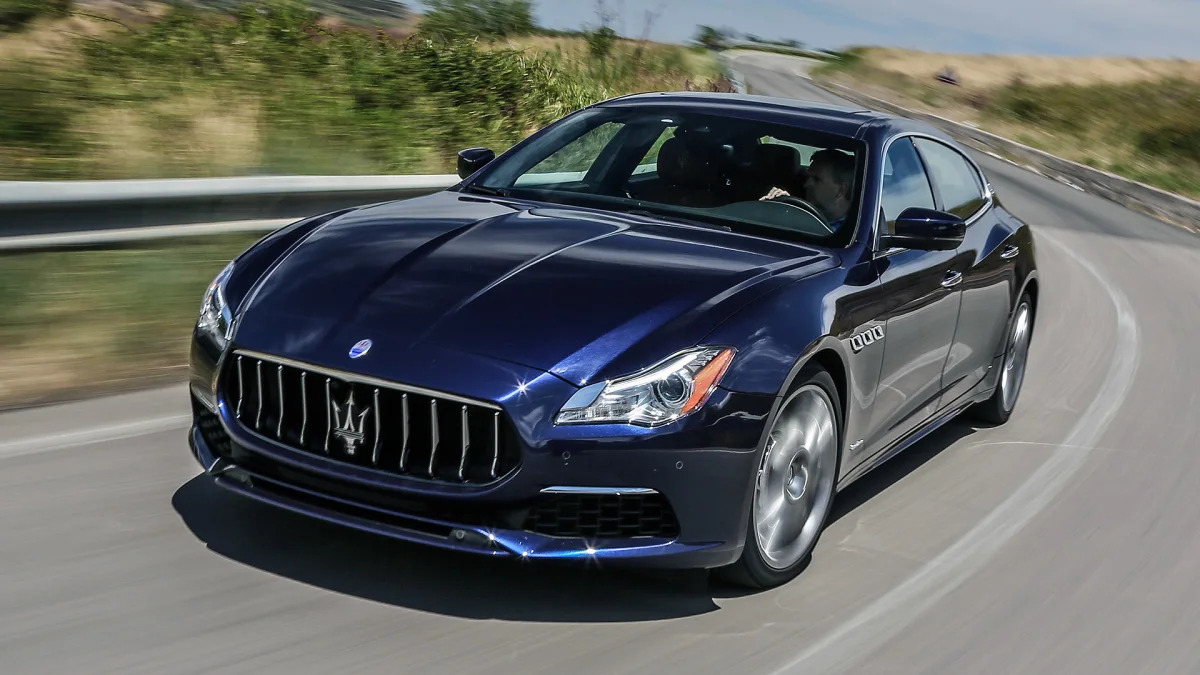








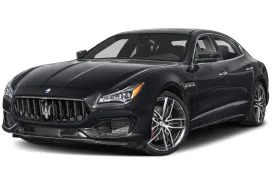
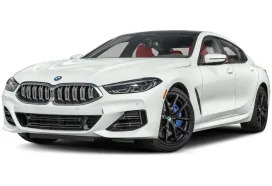
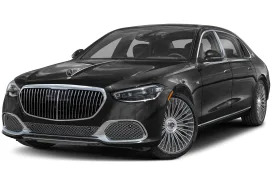

Sign in to post
Please sign in to leave a comment.
Continue